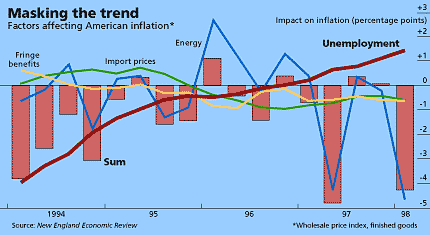NAIRU
SvDs förklaring
Home
The Economist 99-04-24
Is inflation tamed?
Until further notice, the most important question in macroeconomics is whether America really has, as it seems, beaten inflation
For many years economists regarded it as uncontroversial that if unemployment in America fell below 6%, inflation would accelerate. Both the theory and the evidence supporting it seemed impeccable.
But the facts now appear to say otherwise. In 1996 America’s rate of unemployment dipped below 51/2% and kept on falling. Today, remarkably, it stands at a little over 4%.
Inflation should have risen sharply, but it hasn’t. In 1996 consumer-price inflation was 2.9%. In the 12 months to March of this year, the rate was just 1.7%
It would be difficult to exaggerate how much turns on these mysterious facts, not just for America but for the rest of the world as well.
If America can continue to combine unemployment of barely 4%, or even less, with “price stability”, then the economy has undergone a seismic change for the better in its underlying performance - the kind of improvement that might go some way, even, to justify Wall Street’s prolonged and otherwise outlandish exuberance.
If on the other hand it cannot sustain this miraculous combination, then the Federal Reserve will sooner or later have to curb inflation by raising interest rates. The disappointment in financial markets would be great - and the shock would be felt all around the world.
The Economics Focus of January 16th drew attention to one novel explanation of why America’s so-called natural rate of unemployment might have fallen - namely that the strength of Wall Street has itself affected conditions in the labour market (raising the demand for labour, for any given level of aggregate demand in the economy). That is an intriguing possibility, but a subtle, you might even say exotic, one.
A new study by Roger Brinner, chief economist of the Parthenon Group (a consulting and investment firm based in Boston), takes a more straightforward approach. It also comes to a straightforwardly disturbing conclusion. Inflation, Mr Brinner finds, is struggling to break free.
His paper in effect unpacks the standard theory, apparently challenged by the current facts, into two parts - one about the labour market, and the other about the connection between the labour market and general price inflation.
So far as the first is concerned, he finds that the old relationship between wages and unemployment still appears to hold. Just as the natural-rate model predicted, inflation in wages, over and above inflation in prices, has been increasing ever since the end of 1996, when the unemployment rate fell below 51/2%. So America has not suppressed inflation in prices by means of a structural improvement in the labour market.
This evidence is entirely consistent with the view that the natural
rate not only still exists but has stayed at roughly 51/2%.
So why has inflation not risen? Because of an interruption in the
usual link between the wage pressure that comes with very low
unemployment and the resulting upward pressure on prices.
Which brings us to the second part: an account of the favourable “supply
shocks” that might have affected that link. Mr Brinner examines
four such factors:
oil prices (they fell in 1997 and plunged in 1998);
import costs (low lately because of the strong dollar);
our old friend Wall Street (this time, not because high share
prices have increased the underlying demand for labour, but because
they have made it cheaper for firms to finance their employees’
pensions);
and health-care expenses (whose rate of increase has been falling
because of greater competition among providers and pressure from
employers and the government).
He finds that, taken together, these special factors are enough to explain why the increase in wage pressure due to tight labour markets has not fed through to prices. Or not yet, anyway. The chart summarises his results.

It shows the joint and several influence on prices (measured as
percentage points of extra inflation) from unemployment, import
prices, cheap oil and the cost of employer-provided fringe benefits
(including pensions and health insurance), from 1994 until the first
quarter of 1998.
If you were to plot this information over a decade or two, rather than over just a few years, you would see a clear pattern. The bars, which show the sum of the influences on inflation, would as a rule track the bold line, showing the influence of unemployment, quite closely. The other lines have tended to cancel out except at times of very marked fluctuations in energy prices.
But from 1996 onwards, as the chart shows, the bold line - think of it as the change in underlying inflation - has turned increasingly positive, because unemployment has fallen below its natural rate; whereas the bars have been, on average, firmly negative.
The conclusion is plain. These downward pressures are likely to prove temporary. When their benign influence fades, the inflationary pressure due to low unemployment will come though as normal. There is no “new economy”. Sooner or later inflation will cast off its chains.
“Is Inflation Dead?” New England Economic Review (published by the Federal Reserve Bank of Boston), January/February 1999.